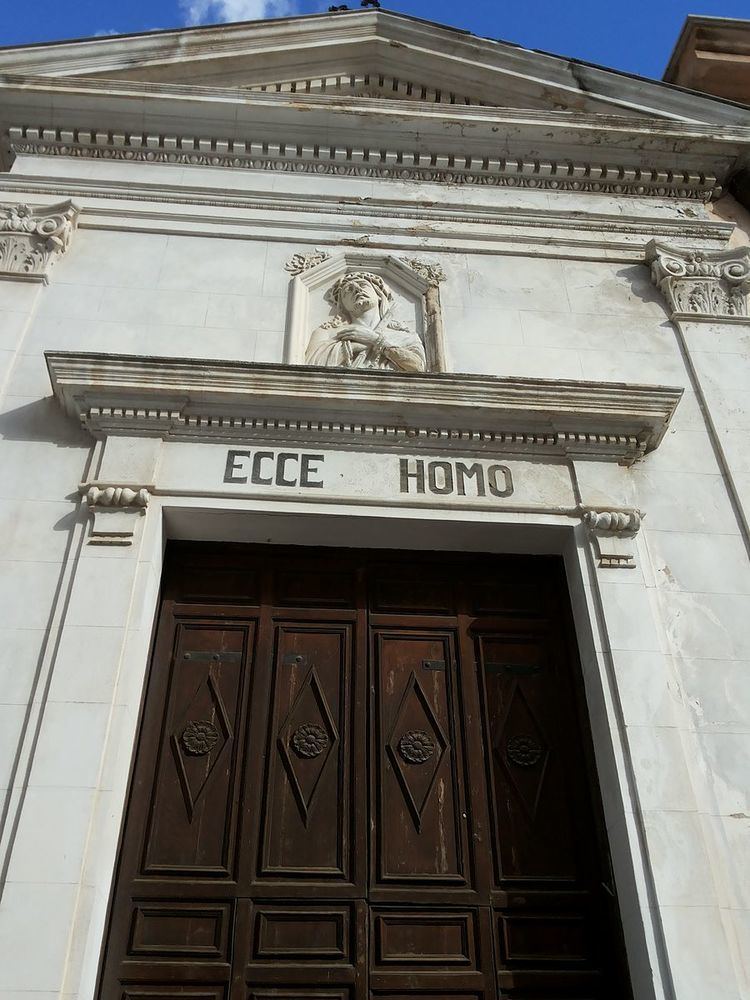Rite Catholic State Italy Patron Ecce Homo Region Sicily Territory Alcamo | Municipality Alcamo Year consecrated 1754 Province Province of Ragusa Groundbreaking 1753 | |
 | ||
Location Alcamo, province of Trapani, Italy Address 97100 Ragusa, Province of Ragusa, Italy Similar Santa Maria delle Scale - Ra, Museum Archeologico Ibleo Rag, Duomo of San Giorgio, Donnafugata Castle | ||
The Church of Ecce Homo was a catholic Church in Alcamo, in the province of Trapani.
Contents
Historical hints
The present Church was built in 1753 on the same spot where there was a chapel, called the Crocifissello (that is the small Crucifix) close to the western town walls; in fact, as it was very little, the members of the Congregation asked the municipality of that time, the authorization to have the chapel’s courtyard in order to build a wider Church there.
The construction started in 1753 and was completed the following year; the building was closed to service because of the 1968 Belice earthquake. After a lot of years, in 1986, the Monuments and Fine Arts Department of Trapani decided a first restoration work including the consolidation of the Church, the vault and the roof.
Later, in 1992 the Department disposed the completing of the works, and they repaired the stuccoes, replaced the frames, adapted the systems, made the gildings and painted the Church.
Today the Church of the Most Holy Ecce Homo is no longer a temple left to itself, on the contrary, it is a monument rescued from decay, and it has recently been used as an auditorium and as a meeting place for cultural events.
Description and works
The church has a simple portal, surmounted by a niche where you can see a marble alto-rilievo panel representing Ecce Homo.
There is one circular nave, similar to that one in the Saints Cosma and Damiano's Church, with beautiful Settecento stucco decorations on the vault; it has an emispheric shape, with four webs surmounting the windows ending on masonry pillars.
Inside the webs there are represented the profecy of the Passion, the Flagellation, the Calvary and the Risen’s Cross:; in the middle of the vault there are the Holy Ghost, as a dove, and the Holy Bible.
There are three altars and these works:
The Congregation
The Congregation of the Most Holy Ecce Homo, founded at about 1750 by canonico Don Vincenzo Fiderico, Chapelain of the Hospital Santo Spirito e San Vito and its first Rector, was formed by butchers and other merchants, who, owing to their working hours, were used to meet on Friday night in this Church for their spiritual meetings.
After having been hosted in other churches, in 1753 the bishop of Mazara del Vallo, after some pressing requests made by Congregation, gave them the Church of the Crocifissello, in the district of Chiesa Madre and adjoining a courtyard limited by the old town walls and some houses.
The main scopes were these:
These people were excluded:
•All women
•Noblemen or teachers or dignitaries of any kind
•Immoral, irreligious and ed heretical people
•The people condemned for public or private crimes or guity of illegal purchase of Church property
•Dissolute or scandalous people, such as concubinaries, adulterers, blasfemers, violators of festivities.
The feast was celebrated on the first Friday of March and it was preceded by a week of spiritual exercises and followed by the Forty Hours Devotion. During the rites and processions, the members of the congregation wore a cloth scapular with two violet ribbons at their ends: one side, with the image of Ecce Homo, was hanging on their chest, and the other, behind their shoulders, had the embroidery of a crown made by thorns and three nails inside it.
The Congregation existed until 1968, when the Belice earthquake damaged its structure remarkably and the Church was unfit for use..
